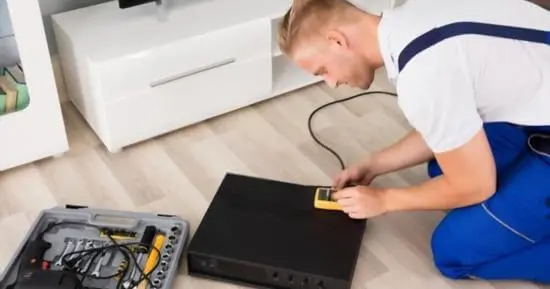Learn how to tune an amp with a multimeter. Amplifiers are electronic appliances that are mostly used in sound systems. This sound system may be present in the car or homes, but the amplifier has a great deal to do with the quality of the speakers.
The sound we get from the speaker depends upon the quality and efficiency of the amplifier. The amplifier is a device that helps to increase the current level or voltage with time, so the amplifier is used to increase the amplitude of the signal to get a great and loud sound from the speaker.
Now, if you have speakers at your home or in your cars, it is necessary to know what problems can lead to a faulty amplifier and how to tune it using a multimeter.
A multimeter is a device that can measure the voltage, resistance and current in different electrical appliances. So in the case of an amplifier, the best rescuer in this condition is a digital multimeter, a handy and easy-to-use tool. So you can use the multimeter to tune your amplifier. The procedure consists of a few steps, which you have to follow one by one, and then you can tune your amplifier easily.
Before moving towards tuning the amplifier with the multimeter, we will first talk about the importance of tuning the amplifier so you will know why you should tune your amplifier after a few days.
Table of Contents
ToggleImportance of tuning an amplifier
Most people do not pay attention to the tuning of the amplifier. If their sound system is not working properly, they immediately buy a new one for them.
Getting rid of the old one and buying a new sound system will not always be a good option because proper care is also needed here; you should tune your amplifier after a few days to improve its quality.
A sound system needs tuning to work properly. Otherwise, it will give a bad quality sound to you, from which you will think that your sound system is not of good quality, and you will move towards buying a new one.
So you should know how to tune your amplifier because it is good for the health of your sound system. It would be best if you learned how to tune the amplifier and pay attention to this matter to get a full service of your sound system. So if you want to enjoy it fully, keep tuning your amplifier to get a good quality sound from your sound system. This article will teach you how to tune an amp with a multimeter.
So that you can use this procedure every time your speaker starts giving a sound of bad quality.
How to tune an amp with a multimeter?
Before moving towards the whole procedure of tuning an amp with a multimeter, we will first enlist some essentials of this process: the tools and items you will need to proceed with the following steps.
- As of now, you will learn how to tune an amplifier, so first of all, you will need an amplifier.
- The second thing will be the speakers you connect to the amplifier during the test.
- The third thing you will need is the digital multimeter, which will help you tune your amplifier.
- Remember to keep the user manual of the amplifier with you.
- Then you will need a digital calculator, which you can use to add up all the results of the voltage measurements.
- Then you should have an audio source of a frequency of around 60 Hertz.
After managing the availability of all these above-enlisted essential tools and equipment to conduct this procedure, you must follow the following briefly explained steps one by one to tune your amplifier efficiently.
-
Calculate the resistance of your speaker by using the digital multimeter:
The first step of tuning the amplifier with the multimeter is checking the resistance of your speaker. You must turn off the speaker’s voltage and power supply. After this, you have to set the multimeter to record the resistance.
For this, you will turn the knob of the multimeter towards the ohm. The multimeter is ready to calculate the resistance, so now you have to connect the speaker to the multimeter, as the multimeter is the device that will check the speaker’s resistance.
You have to connect the black probe of the multimeter with the negative terminal of the speaker and the red probe of the multimeter with the positive terminal of your speaker.
After connecting the leads, you will get a resulting resistance value which will be displayed on the screen of the multimeter. Read out the value of the results.
The maximum resistance value should be 2,4 or between 8 to 16 ohms. So take the closest value from these ohms values according to the resulting resistance value of the speaker.
-
Compare the amplifier’s wattage output:
Check the user manual of the amplifier. Here you will get the recommended value of the wattage output. Here you have to compare this value with the resulting resistance value of the speaker.
-
Measure the target AC voltage:
This is an important step of the whole procedure because from here, we will get the actual target AC voltage upon which we have to set the gain of the amplifier. For this, we have to apply the variation of ohm’s law.
For example, if the user manual of your amplifier says that the amplifier needs 500 watts and if the resulting resistance value of your speaker is 2 ohms, then you have to multiply both these values and in the answer, you will get 1000.
Now you have to use the calculator and calculate the square root of 1000, and the resulting 31.62 value will be the target AC voltage for the one gain of your amplifier. Values can change, but the procedure of calculation will be the same.
-
Set the amplifier:
To set the amplifier for tuning, you have to do a few steps.
- First, you have to unplug all the other appliances, like subwoofers and speakers, from the amplifier.
- You also have to take all the values of the bass boost, loudness, bass, equalizer functions, treble and processing at zero.
- Now turn the dial of the amplified counterclockwise fully.
After doing all these steps now, the amplifier is only attached to the voltage source and is ready for tuning.
-
Apply the sound:
Turn the volume and set it at 75%. Make sure that the amplifier is not connected to the speaker. Now play the test tune on the speaker. Adjust the frequency of the sound.
If you have a mid-range amplifier, then the wavelength of the sound should be around 100 Hertz, and the frequency of the sound for a subwoofer amplifier should be between 50 to 60 Hertz. Play the test tune continuously.
-
Connect the amplifier with the multimeter:
Connect the amplifier with the multimeter by connecting the black probe of the multimeter with the positive terminal of the amplifier and the red probe of the multimeter with the negative terminal of the amplifier. If you get the resulting readings between 1 and 2 volts, then it means your amplifier is in good condition.
-
Adjust the gain knob of the amplifier:
Setting the knob gain of the amplifier means that you will set the amount of power you want to deliver to your device so you can set it on high, medium and low according to your choice. Keep moving the gain knob of the amplifier and keep an eye on the display screen of the multimeter. As soon as the readings on the multimeter reach the target AC voltage value, you must stop turning the knob.
-
Plug the accessories:
As your amplifier has been tuned, you can now connect it with all the accessories like speakers and other amplifiers you have removed before tuning it. Connect all the wires correctly and turn the volume according to your desire.
As your amplifier is tuned according to your speaker, now you can enjoy full music in your car and at home, play your favorite song, and feel the beat with the fairly tuned amplifier.
Final verdict
Amplifiers are an essential part of the sound system. The sound system is nothing without an exactly tuned amplifier. Some people still need to learn to tune their amplifiers to enjoy the music fully, so they buy the amplifier for the speaker but need to know how to tune and connect it properly.
So here in this article, we have told you how to tune an amp with a multimeter according to the requirement of the speaker.
This article will help you tune your amplifier correctly and enjoy your favorite music while traveling and chilling at home. Follow all the steps carefully and learn how to tune an amp with a multimeter using this article. Try this method on any amplifier and learn to tune it without getting in trouble with buying a new speaker this time.
Related Guides:





